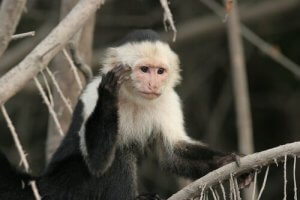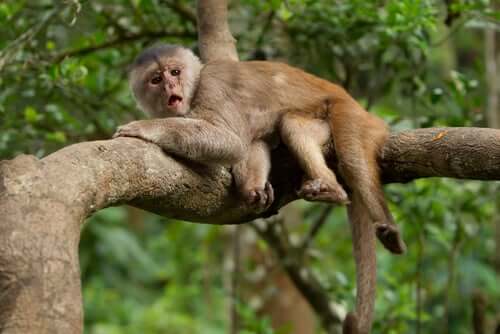Capuchin Monkey: Characteristics, Behavior, and Habitat


Written and verified by the vet Eugenio Fernández Suárez
When talking about primates, the capuchin monkey is, without doubt, one of the most well known. This special monkey lives in South America and there are several different species, all belonging to the Cebidae family of primates.
Capuchin monkey characteristics
They’re small monkeys, measuring just a foot and a half tall, and they usually have dark ridges or tufts on their forehead, which are related to their dominance within the group.
All species of capuchin monkeys have a prehensile tail. This means that they can use it as a fifth limb and it even has the same sensitivity as their hands.
Capuchin monkeys are very sociable primates and live in groups. They mainly eat fruit, tender leaves, and small animals, such as birds or insects. There are multiple species, although the following are the best known:
- The most well known is the tufted capuchin, which is the most common primate in the Neotropics after humans. They have a brown coat with erect black hair on their forehead.
- Azara’s capuchin is similar but has a longer coat.
- The white-faced capuchin is another of the best known, characterized by a black and white coat. Their head almost resembles the hood of a capuchin monk.
All species of capuchin monkeys have a prehensile tail. This means that they can use it as a fifth limb and it even has the same sensitivity as their hands.

Behavior
This primate species has a reputation for being the smartest mid-size monkey, second only to the great apes. This is mainly because they are one of the best examples of animals that use tools.
Capuchin monkeys use rocks and stones to open nuts, and they teach their offspring how to do it too. They can also use other tools and, in fact, there is archeological evidence that they’ve done this for thousands of years. This would mean that this species’ tools are the oldest animal tools outside of Africa.
One of the most fascinating things that they do involves onions. This vegetable has anti-parasitic properties which the capuchin monkey uses to repel mosquitos and other insects. The groups call meetings, known as onion baths, where they each rub each other with an onion bulb.
But this doesn’t just keep the mosquitos away; it also functions as a form of social grooming. The individual monkeys thereby strengthen their ties to the rest of the group and help each other with hard to reach areas. When observed, they’re clearly very happy and make a lot of vocalizations.
Capuchin monkey groups call meetings, known as onion baths, where they each rub each other with an onion bulb.
Habitat
All capuchin monkeys live in northern South America and Central America, and they’re all arboreal primates. This means that they live in the region’s rain forests.
Most species of capuchin monkeys are abundant in number, and not in any way endangered. There are only a few very threatened species, such as the golden-bellied capuchin or the blond capuchin.
However, although they’re not endangered, the more abundant species are still under threat. Unfortunately, their expressiveness and charisma have made them one of the most illegally trafficked animals, along with the pygmy marmoset. Obviously, then, you can’t have a capuchin monkey as a pet.
This has also made them victims of the movie industry. Young capuchin monkeys are taken away from their mothers to be trained as actors and end up appearing in well-known movies. Luckily, these days, they can be reproduced using special effects, but there are many productions that continue to use these animals.
The capuchin monkey still populates the largest jungle in the world, but both deforestation and the monkeys’ own charisma are endangering the future of the species and its ecosystem, which is one of the planet’s main lungs.
When talking about primates, the capuchin monkey is, without doubt, one of the most well known. This special monkey lives in South America and there are several different species, all belonging to the Cebidae family of primates.
Capuchin monkey characteristics
They’re small monkeys, measuring just a foot and a half tall, and they usually have dark ridges or tufts on their forehead, which are related to their dominance within the group.
All species of capuchin monkeys have a prehensile tail. This means that they can use it as a fifth limb and it even has the same sensitivity as their hands.
Capuchin monkeys are very sociable primates and live in groups. They mainly eat fruit, tender leaves, and small animals, such as birds or insects. There are multiple species, although the following are the best known:
- The most well known is the tufted capuchin, which is the most common primate in the Neotropics after humans. They have a brown coat with erect black hair on their forehead.
- Azara’s capuchin is similar but has a longer coat.
- The white-faced capuchin is another of the best known, characterized by a black and white coat. Their head almost resembles the hood of a capuchin monk.
All species of capuchin monkeys have a prehensile tail. This means that they can use it as a fifth limb and it even has the same sensitivity as their hands.

Behavior
This primate species has a reputation for being the smartest mid-size monkey, second only to the great apes. This is mainly because they are one of the best examples of animals that use tools.
Capuchin monkeys use rocks and stones to open nuts, and they teach their offspring how to do it too. They can also use other tools and, in fact, there is archeological evidence that they’ve done this for thousands of years. This would mean that this species’ tools are the oldest animal tools outside of Africa.
One of the most fascinating things that they do involves onions. This vegetable has anti-parasitic properties which the capuchin monkey uses to repel mosquitos and other insects. The groups call meetings, known as onion baths, where they each rub each other with an onion bulb.
But this doesn’t just keep the mosquitos away; it also functions as a form of social grooming. The individual monkeys thereby strengthen their ties to the rest of the group and help each other with hard to reach areas. When observed, they’re clearly very happy and make a lot of vocalizations.
Capuchin monkey groups call meetings, known as onion baths, where they each rub each other with an onion bulb.
Habitat
All capuchin monkeys live in northern South America and Central America, and they’re all arboreal primates. This means that they live in the region’s rain forests.
Most species of capuchin monkeys are abundant in number, and not in any way endangered. There are only a few very threatened species, such as the golden-bellied capuchin or the blond capuchin.
However, although they’re not endangered, the more abundant species are still under threat. Unfortunately, their expressiveness and charisma have made them one of the most illegally trafficked animals, along with the pygmy marmoset. Obviously, then, you can’t have a capuchin monkey as a pet.
This has also made them victims of the movie industry. Young capuchin monkeys are taken away from their mothers to be trained as actors and end up appearing in well-known movies. Luckily, these days, they can be reproduced using special effects, but there are many productions that continue to use these animals.
The capuchin monkey still populates the largest jungle in the world, but both deforestation and the monkeys’ own charisma are endangering the future of the species and its ecosystem, which is one of the planet’s main lungs.
All cited sources were thoroughly reviewed by our team to ensure their quality, reliability, currency, and validity. The bibliography of this article was considered reliable and of academic or scientific accuracy.
- Anderson, R. (2003). “Cebus apella” (On-line), Animal Diversity Web. Consultado 25 de abril de 2023. https://animaldiversity.org/accounts/Cebus_apella/
- Valença-Montenegro, M.M., Bezerra, B.M., Martins, A.B., Jerusalinsky, L., Fialho, M.S. & Lynch Alfaro, J.W. (2021). Sapajus flavius (amended version of 2020 assessment). The IUCN Red List of Threatened Species 2021: e.T136253A192592928. https://www.iucnredlist.org/species/136253/192592928
- Stone, A. I. (2017). Cebids (Cebinae). The international encyclopedia of primatology, 1-3. John Wiley & Sons, Inc. https://onlinelibrary.wiley.com/doi/abs/10.1002/9781119179313.wbprim0076
- IUCN SSC Primate Specialist Group. (2021). Pongo abelii. The IUCN Red List of Threatened Species. https://www.iucnredlist.org/species/172351505/192594550
- Bowler, M., Messer, E. J., Claidière, N., & Whiten, A. (2015). Mutual medication in capuchin monkeys–Social anointing improves coverage of topically applied anti-parasite medicines. Scientific Reports, 5. https://www.ncbi.nlm.nih.gov/pmc/articles/PMC4601033/
- Dewey, T. (2008). “Cebidae” (On-line), Animal Diversity Web. Consultado 25 de abril de 2023. https://animaldiversity.org/accounts/Cebidae/
- Meunier, H., Petit, O., & Deneubourg, J. L. (2008). Social facilitation of fur rubbing behavior in white‐faced capuchins. American Journal of Primatology: Official Journal of the American Society of Primatologists, 70(2), 161-168. https://onlinelibrary.wiley.com/doi/abs/10.1002/ajp.20468
- Visalberghi, E., Sirianni, G., Fragaszy, D., & Boesch, C. (2015). Percussive tool use by Taï Western chimpanzees and Fazenda Boa Vista bearded capuchin monkeys: a comparison. Philosophical Transactions of the Royal Society B: Biological Sciences, 370(1682), 20140351. https://royalsocietypublishing.org/doi/full/10.1098/rstb.2014.0351
- Falótico, T. (2022). Robust capuchin tool use cognition in the wild. Current Opinion in Behavioral Sciences, 46, 101170. https://www.sciencedirect.com/science/article/pii/S2352154622000766
- de A. Moura, A. C., & Lee, P. C. (2004). Capuchin stone tool use in Caatinga dry forest. Science, 306(5703), 1909-1909. https://www.science.org/doi/abs/10.1126/science.1102558
- Ruiz-García, M., Sanchez-Castillo, S., Castillo, M. I., Luengas, K., Ortega, J. M., Moreno, P., … & Shostell, J. M. (2018). How many species, taxa, or lineages of Cebus albifrons (Platyrrhini, Primates) inhabit Ecuador? insights from mitogenomics. International Journal of Primatology, 39, 1068-1104. https://link.springer.com/article/10.1007/s10764-018-0062-6
- Alfaro, J. W. L., Matthews, L., Boyette, A. H., Macfarlan, S. J., Phillips, K. A., Falótico, T., … & Alfaro, M. E. (2012). Anointing variation across wild capuchin populations: a review of material preferences, bout frequency and anointing sociality in Cebus and Sapajus. American Journal of Primatology, 74(4), 299-314. https://onlinelibrary.wiley.com/doi/abs/10.1002/ajp.20971
This text is provided for informational purposes only and does not replace consultation with a professional. If in doubt, consult your specialist.








